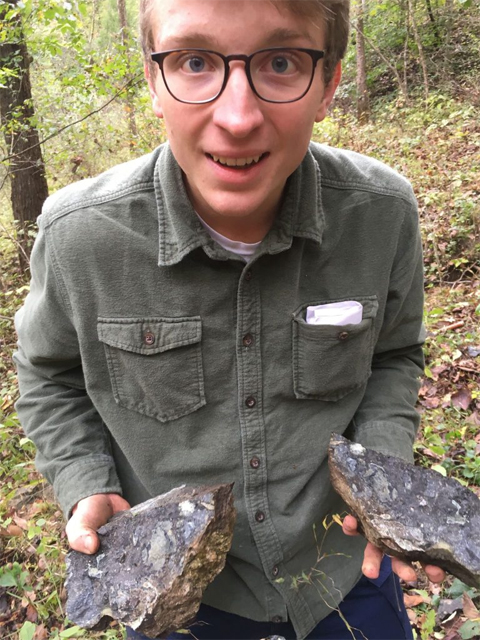
HTC Geological Sciences student Thomas Johns holds samples of kimberlite collected in Elliott County, Ky., which contain pieces of the Earth’s mantle.
A small group of Ohio University students under the direction of Dr. Keith Milam, Associate Professor of Geological Sciences, visited eastern Kentucky in search of samples from the Earth’s mantle in October.
As a part of Thomas Johns‘ Honors Tutorial College geology tutorial project, Johns, Milam, and graduate student Logan Jacobs hiked into the wilds of rural Elliott County in search of a rare rock type called a kimberlite. Kimberlites are igneous rocks that originate deep within the mantle of the Earth—the mantle is between the Earth’s crust and its super-heated core—and rapidly ascend to and erupt at the surface. Oftentimes, these rocks bring up pieces of the mantle and other rocks that are incorporated during the swift ascent. Many kimberlites around the world contain diamonds and are the leading source of diamonds for the jewelry industry.
After many hours of searching through the hills and hollows and consulting old maps, the team was able to locate the dark black and green kimberlite pipe on a remote hillside. This was quite the accomplishment as almost all of the rocks exposed in the state of Kentucky are sedimentary in nature, including the ones in eastern Kentucky.
Although the Elliott County kimberlites do not contain diamonds, they were found to contain fragments of the mantle and the overlying granitic continental crust, as well as the sedimentary rock that lies above. Many of the kimberlites collected by Thomas and Logan contain beautiful specimens of red garnets, reflective phlogopite micas, and emerald green serpentine.
“This was a great trip!” Jacobs said.
Johns is now in the process of cutting and grinding the kimberlite rocks with the Geological Sciences Department’s diamond-impregnated saws and equipment in order to produce thin sections. Thin sections are slabs of minerals or rock, mounted to a glass slide, which are thinner than half the diameter of an average human hair.
Light is passed through a thin section under a microscope. The interactions that occur with the minerals allow geologists such as Johns to identify them. This, in turn allows geologists to tell the “history” of the rock, thousands, millions, or even billions of years after the fact.
As a part of his course project, Thomas will be examining his kimberlite samples to unravel the mysteries of the mantle.



















3 Comments